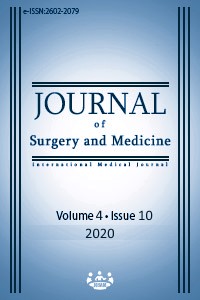Autistic child with abdominal pain caused by foreign body ingestion
Keywords:
Foreign body, intestinal perforation, autism, abdominal painAbstract
Foreign body ingestion is an important condition with a potentially high mortality rate that is encountered in pediatric emergency departments and outpatient polyclinics. Foreign body ingestion occurs in 80% of children, especially those between 6 months and 3 years of age. However, in patients with mental disorders, in this case, autism, foreign body ingestion may occur at any age. A 16-year-old autistic patient presented with complaints of discomfort and restlessness, with no history of ingestion, however, we discovered through further investigations that the patient had in fact swallowed a foreign object. In this case, we would like to emphasize that autistic patients of any age can ingest foreign bodies, even without any suspicious history.
Downloads
References
Kim SY, Park B, Kong IG, Choi HG. Analysis of ingested foreign bodies according to age, type and location: A retrospective observational study. Clin Otolaryngol. 2016;41:640–5.
Gummin DD, Mowry JB, Spyker DA, Brooks DE, Fraser MO, Banner W. 2016 Annual Report of the American Association of Poison Control Centers’ National Poison Data System (NPDS): 34th Annual Report. Clin. Toxicol. 2017;55:1072–52.
Pederiva F, Daniela C, Scarpa MG, Guida E, Dragovic D, Martelossi S. An Asymptomatic Multiple Magnet Ingestion with Transmesenteric Entero-Enteric Fistula. APSP J Case Rep. 2014;5(2):16.
Brown DJ. Small bowel perforation caused by multiple magnet ingestion. J Emerg Med. 2010;39:497-8.
Gün F, Günendi T, Kılıç B, Celik A. Multipl magnet ingestion resulting in small bowel perforation: a case report. Turkish Journal of Trauma & Emergency Surgery. 2013;19(2):177-9.
Downloads
- 458 668
Published
Issue
Section
How to Cite
License
Copyright (c) 2020 Zerrin Özçelik, Didem Gülcü
This work is licensed under a Creative Commons Attribution-NonCommercial-NoDerivatives 4.0 International License.
















